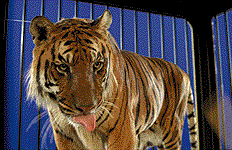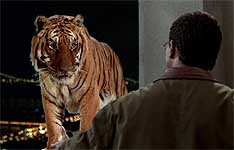n an effort to maintain consistency for the animals throughout the film, the production tried to keep specific animals at specific effects houses, and BFTR handled all of the shots involving the talking circus tiger, Jake. In pain and suffering from a blood clot in his brain, Jake escapes from the circus and plans to end his life by jumping off the top of San Francisco's Coit Tower, only to be rescued and operated upon by Dolittle. While Jim Henson's Creature Shop built and puppeteered an animatronic tiger for certain sequences such as the operating scene, we were charged with digitally animating the real-life tiger in 31 shots.

Many of our shots of Jake the tiger involved the removal of unwanted elements, including cage bars, leashes, and the tiger's real tongue.
©1998 Twentieth Century Fox
|
Jake the Tiger, with a voice provided by Albert Brooks, was a pivotal character in the film, providing the life-or-death plot situation that galvanizes Dolittle to action. As such, we had to give Jake a level of sympathy and depth that was quite different than the broader comedic character of most of the other animals in the film; at the same time, however, we had to maintain a comedic edge. Now, the real live tigers who performed on set had a wide range
of expressions to begin with: bored, skeptical, bored, inattentive, bored, oblivious and bored. While the skeptical part was useful in certain deadpan shots, to complement Albert Brooks' vocal performance we had to add many more to that range: pained, vulnerable, grumpy, inquisitive, hopeful, annoyed, accusative, surprised, pleading and very ill. Like actors, we worked on our timing and massaged our character's facial expressions to create the richest, most entertaining performance possible. Spearheading the tiger animation were lead artist Erich Ippen, BFTR supervisor Van Ling and artist Martha Soehendra. (For a complete list of BFTR credits, click here.)
When you're filming a live animal, you have to capture lightning in a bottle... and worry about hiding the bottle itself later. And these bottles were numerous.
In order to maintain safety on the set for both animal and crew, strong leashes were used to keep Jake from wandering. This coupled with the characteristically short feline attention span, meant that there were often many "artifacts" intruding into frame: leash cables (and their shadows) that often crossed in front of the animal and in some cases ruffled and pressed into his fur; colored tape and blocks of wood on the floor (which the animals were trained to hit as marks); trainers waving meat on a stick to get (and keep) the tiger's attention; milk (a favorite attention-getting reward) and drool dribbling from his mouth; and an unbelievably prehensile tongue that would not only obscure but often distort portions of the big cat's features as he cleaned

Of the utmost importance to our animators was conveying the broad range of emotions the tiger was experiencing in our sequences.©1998 Twentieth Century Fox
|
himself. BFTR's artists had to address these artifacts before the animation of dialogue and performance could even begin.
Artists Todd Vaziri and Travis Langley were charged with removing all of these artifacts using Adobe After Effects, Photoshop and Puffin Designs' Commotion, returning the bluescreen elements to a "clean" state --as if they had been shot under ideal conditions in the first place. Only then could we pull the bluescreen mattes for compositing, which we did using After Effects.
Some of the tiger shots that ultimately required the animal to speak on camera had not been shot with the talking in mind, and as a result, had been shot with a non-motion-control moving camera and with the animal's face partially occluded by cage bars! For several shots, BFTR's artists had to animate Jake the tiger's dialogue and expressions behind the bars. In other instances, bluescreen shots of the tiger pacing in his cage from a deleted scene were used in the Coit Tower sequence, necessitating the removal of the bars (and their shadows) entirely.
Since at no point during the production of DR. DOLITTLE were actor Eddie Murphy and the trained tiger actually photographed together in close proximity, the illusion of their interaction required careful compositing. For the Coit Tower sequence, for example, the tiger and Murphy were shot separately against a bluescreen on a soundstage, with Eddie staring at a suspended tennis ball for an eye line and the tiger staring at a piece of meat on a stick being waved by a trainer. A background plate of the San Francisco night skyline, shot in clear focus, had to be repositioned, blurred and the lights bloomed to make the shots look much more realistic.
Pulling a bluescreen matte from soft-focus night elements and fur was a challenge enough, but probably the most difficult task was dealing with the tiger's long whiskers, which were of course present in every shot; they drooped from his cheeks down to below his chin, so animating the chin and mouth in a realistic manner meant isolating the whiskers and making them move realistically as well, without them warping, stretching or even disappearing from time to time. continued...
